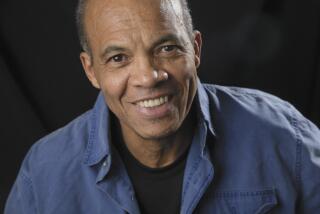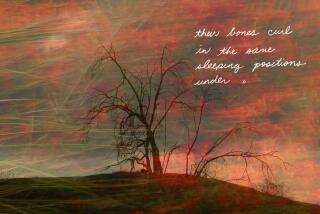A Poet’s License : ROBERT GRAVES: Life on the Edge,<i> By Miranda Seymour (Henry Holt: $37.50; 524 pp.)</i>
Since the age of 15, poetry has been my ruling passion and I have never intentionally undertaken any task or formed any relationship that seemed inconsistent with poetic principles, which has sometimes won me the reputation of an eccentric.
--Robert Graves
****
Biographers are often compelled to act like vultures, waiting till the objects of their interest die before they can set to work. Writer Robert Graves died in 1985. Poet Laura Riding Jackson, who played a pivotal role in his life and who nursed progressively more ferocious feelings toward Graves after she broke with him, died in 1993. So now the coast is relatively clear. With permission from Graves’ widow, Beryl, and one son, Miranda Seymour is the first to attempt a comprehensive life story.
Graves would have celebrated his 100th birthday this year. To date, there’s been no movie made of his life, although his biography is full of high drama and juicy tales of sexual obsession, self-imposed exile, May-December romances, a bevy of mistresses, bitter literary in-fighting, an angry abandoned first wife and a long, suffering second spouse.
Author of more than 50 books of poetry, 20 works of fiction and more than 40 of nonfiction, devoted mythologist in more ways than one, Graves was also an active translator and editor. He was as dedicated a poet, in his way, as one is likely to find. Much of his poetry is beautiful, insistent, ringing with emotion, thundering with archetypal symbolism. Seymour describes certain particularly tender Graves love poems as reading “as if murmured across the pillows.”
Based on Seymour’s biography, a good opening scene in the Robert Graves movie might be the World War I battle in which 20-year-old Capt. Graves was wounded so badly that news of his death was sent to his parents. While loved ones mourned, contrary Graves, a man who would often flout convention in later life, recovered, although he was plagued by shell-shock the rest of his life.
Seymour has done a fine job both in terms of research (to the extent of this reviewer’s ability to judge, not being a Graves scholar) and objectivity. The latter becomes central because Graves’ personal life contains material that might tempt a writer to judge him harshly. He was a complicated man, and Seymour wisely does not simplify or whitewash him. The tone of her prose indicates that she struggled hard to maintain an open mind while plumbing key players’ motivations.
This is a good note for a biography of Graves to strike. Such an editorial stance leaves readers free to have a full range of reactions to the text, because the biographer hasn’t taken all the fun away by having done it for them. Here’s an example of Seymour striving to create balance for readers about not villainizing the oh-so villainizable Laura Riding: “It is easy to exaggerate the grimmer side of Riding’s personality. It should never be allowed to overshadow her charisma or the fact that there was a girlish, playful aspect to her character which Graves loved quite as much as her exceptional intelligence.”
Some pages later, Seymour calmly relates an incident in which 7-year-old Catherine Graves (one of Robert’s daughters with his first wife, Nancy) is encouraged by the girlish, playful Riding to climb out a dangerously high window. A page or so later, Riding throws herself out a window and breaks her pelvis, apparently in a fit of pique over a follower of hers who announced he was leaving the fold.
A busy man, Graves fathered two broods of children, the first of which he abandoned, at least temporarily, when he ran off with Riding. Seymour quotes from a letter Graves wrote Nancy after he’d left and taken a flat with Riding, a missive not designed to win sympathy from advocates of parental responsibility: “The children are yours; you are their mother. I am their father, but they are not my charges, I feel, only my friends. I hate being away from them but I do not feel anxious about them in a paternal way. . . .”
Graves is probably not destined to become a feminist icon either, despite his proclivities for goddess worship. In 1964, he published a book of poems bearing the intriguing title “Man Does, Woman Is.” He developed what amounted to a personal religion, which consisted in part of the belief that as a true poet, it was essential to him to have a woman in his life to act as muse, his link to the goddess. When their paths crossed, he must love and worship these women, sexually, emotionally and spiritually. As his muse’s poet, he could deny her nothing and owed her unflagging allegiance. The effects that Graves’ adherence to these beliefs had on his families, friendships, finances and writing career form much of the story Seymour relates.
Although Seymour isn’t afraid to pose the unanswerable question about Graves, she has the sense to leave open “the question of whether Graves had a growing hunger for beautiful young women which he chose to disguise as poetic inspiration.”
At 524 pages, the biography is thorough. It’s puzzling, though, why the introduction was included--it seems to be nothing more than an encapsulation of the book, stuck on at the front. Seymour’s writing is intelligent, detailed and readable, packed with information. She has a flair for the zippy one-line characterizations (“Lord Falkland was a vain, roving-eyed old peer with the looks of an Elizabethan sea captain and a family who had swashbuckled their way through history for several centuries”).
For the film’s final scene, perhaps they’ll use a shot of whatever hulking actor plays Graves, at his 85th birthday party, tended by Beryl, his brilliant mind essentially gone--as Seymour puts it, “dressed like a child in a baby-blue caftan, and being given children’s presents in brightly colored paper.”
More to Read
Sign up for our Book Club newsletter
Get the latest news, events and more from the Los Angeles Times Book Club, and help us get L.A. reading and talking.
You may occasionally receive promotional content from the Los Angeles Times.







